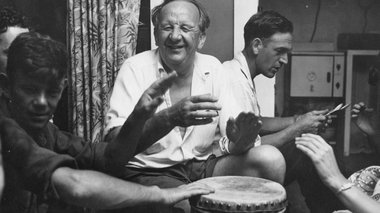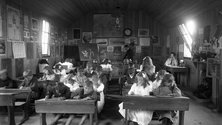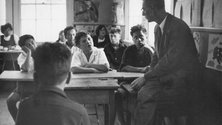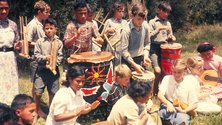Peter Ireland – 16 March, 2017
Even outside the film's unabashed special pleading it's clear that Tovey's experiment bore fruit, both in achieving its educational aims and inadvertently sparking initiatives such as the formation and development of contemporary Maori art. The question to be asked is was it simply a creature of its time and place with little relevance now? Could it have flourished only within the much simpler social circumstances of the 1940s and ‘50s?
Luit Bieringa (director); Jan Bieringa (producer)
The heART of the matter
Wellington 2016
With the appointment of new Education Secretary, Betsy deVos, recently confirmed by the US Senate - and the attendant public education system there considered to be impacted by policies of privatisation - it seems timely to consider the history and implications of a new educational drive which happened in New Zealand over a period of thirty years from after 1940: the subject of a film released last year by the Bieringas and launched nationwide during last winter’s annual nationwide Film Festival. DeVos, a wealthy Republican donor with a financial interest in promoting charter schools, will now oversee a Trump campaign promise to divert $US20 billion of public system funds to provide school vouchers. During the Senate confirmation hearing she suggested some schools may need guns to protect themselves from grizzlies.
The Bieringas’ film is also about an experiment: a social documentary about an educational experiment in New Zealand. Implicit in these statements are notions of political position, historical context, nostalgia, grief and hope. In production terms it’s also about sheer doggedness: almost forty years ago Luit Bieringa began gathering material relating to the work of Education Department official Gordon Tovey, simply to ensure that an archive be established, the material not lost.
In a sense, this documentary as a film still resembles that archive in its impressionistic quality: a sense of information and imagery being withdrawn - not quite randomly - from a vertical file memory rather than its being a seamless movie narrative. However, like any good impressionist object it sparkles with light and one’s retina retains much that is indelible visually and otherwise unforgettable.
The heART of the matter tells a complex and richly-layered story, and its mere 90 minutes could never contain its threads’ arguments consistently and fully-rounded. Fundamentally it’s a passionate plea for at least a re-consideration in these days of fairly confused, market-related educational policies of the more human development orientations of “the Tovey years” based firmly on belief in the primacy and fairness of a public system.
How did these years come about? Any political educational policies are grounded in two things: citizenship and employment, a mix of idealism and pragmatism, with one aspect dominating at one time, the other at another. Since the years of the Liberal government towards the end of the 19th century - where modern New Zealand has its roots - educational policy developed in tune with urbanisation and higher expectations. The Great War of 1914-18 may have indicated that the international system wasn’t working but the Great Depression of the 1930s went further, having a domestic impact greater than anything the earlier war had brought to this country. The system needed rebuilding from the ground up. With the old political parties largely discredited by 1935 the electorate embraced the hope offered by Michael Joseph Savage and his Labour Party.
The Minister of Education then was the visionary Peter Fraser, who in 1940 appointed Dr Clarence Beeby as Director of Education (1). Shortly afterwards Beeby composed the sentence which guided policy for the following forty years: “Every person, whatever his level of ability, whether he be rich or poor, whether he live in town or country, has the right, as a citizen, to a free education of a kind for which he is best suited and to the fullest extent of his powers.”
The kind of rote learning characterising education at the point was not completely abandoned, but found a new context within a much wider practice which trusted individual experience as knowledge and a tool to develop the human person as a confident member of a forward-looking and harmonious society. This new context was an arts-centred education system which honoured traditions of Maori art for the first time - partly a strategy to engage Maori children more with formal education but partly to open up a bicultural perspective to more Pakeha children.
Conjuring this policy into being from 1946 was Gordon Tovey, a former head of Dunedin’s art school and later art lecturer at the Teachers’ College there. As the first Supervior of Art and Craft for the Department, Tovey had both a national canvas and a free hand to develop policy implementation to a degree almost impossible to imagine in today’s risk-averse bureaucratic climate with its mania for box-ticking assessment. But, he made things happen.
His vision, organising ability and charisma - supported by the trust of his departmental superiors - drew a number of young, eager and committed teachers to help launch these new programmes throughout New Zealand. The heART of the matter charts the development of this experiment over the twenty years of its flourishing, using archival film of the time and later interviews with some of the students and many of the teachers involved: Roger Hardie, David Aitken, Marilynn Webb, Cliff Whiting, Clive Arlidge and Paratene Matchitt - and including the reminiscences of Tovey’s only child and biographer Carol Henderson, who was also a specialist teacher on the scheme (2). This group of influential disciples has come to be known collectively as “The Tovey Generation”, especially those Maori teachers such as Arnold Wilson, Fred Graham, Katarina Mataira, Ralph Hotere, Sandy Adsett, Cliff Whiting, Cath Brown, John Bevan Ford and Para Matchitt whose involvement in the programme - and the sense of collectivity it fostered - lead them to lay the foundations of what later came to be known as contemporary Maori art.
This emergent programme had two crucial periods. The first was Tovey’s work from 1946 until 1960, establishing his network of arts educators throughout New Zealand. The first phase of this was using a number of sympathetic schools with large Maori components in a relatively close-knit area as sites for this arts-activity experimentation. Initially Tovey looked to the East Coast, but the influential Sir Apirana Ngata was against the idea. Northland provided more fertile gound, beginning at Oruaiti then at Ngataki, which lead to the desired matix of schools at Pukepoto, Paparore, Te Hapua and Oturu. Known as the Northern Maori Project this enterprise flourished between 1954 and 1959, but not always with the full support of regional managers of the inspectors working out of Auckland for whom Tovey’s liberal and free-wheeling approach severely tested their educational beliefs and operational habits. But the NMP acted as a beacon, and soon there were other cells operating throughout the country, involving both Maori and Pakeha teachers.
Before the oft-abused term gained currency in the 1980s, biculturalism was a notion underpinning Tovey’s vision for the future in the 1950s. He not only saw beyond Modernism’s formal interest in “primitive art” - respecting Maori art practice as embedded in a living culture - but he had seen art-making work in predominantly Maori schools in the far North, giving those students a stronger identity, a pride and confidence the conventional educational system had failed to bestow. As Rawiri (Henry) Henare says right at the beginning of the film: “School was wonderful - I just wanted to be there.” Tovey also believed that Pakeha children might benefit similarly from such an experience of art-making and exposure to indigenous art and craft (3). He may have been an idealist but he was politician enough to know how to bide his time.
Once his troops had sufficient field experience during the 1950s Tovey initiated the second crucial period of the scheme’s development. This, like to official birth of photography, has a place and date: Ruatoria, March 1960. However, the year before he had gone to Tikitiki to seek out master carver Pineamine Taiapa, aware of Ngata’s earlier discouragement but hopeful the artist in Taiapa might respond more positively to what he was proposing. The outcome was the Ruatoria conference the following year, where the Department’s art and craft advisors - including Whiting, Matchitt and Hotere - met to talk and work with Taiapa and others, to see what understandings might emerge and initiatives generated. Initially though, there was some suspicion this could be yet another Pakeha exploitation of Maori imagery and practice for commercial gain. Tovey said: “We come to you like a lover that has been lost for a long time” and that inspired observation turned the suspicion around into trust and collaboration (4).
This breakthrough lead to Tovey realising a long-cherished project, the Department’s Art and Craft Branch publishing a series of educational booklets, beginning in 1961, on a range of Maori customary practices such as weaving, carving, haka and songs which introduced two generations of post-WWII Pakeha children to the practicalities and cultural significance of traditions central to the identity of tangata whenua.
Despite the now-full implementation of the programme, a number of strains both personal and professional had begun taking their toll on Tovey since the middle 1950s. He many have been an inspiring visionary and effective organiser, but time revealed him as a flawed human being. His long-standing affair with art specialist Esther Archdall had become common knowledge (causing much distress to Heather his wife and daughter Carol) (5), the greater Maori orientation of his educational aims provoked conflict among colleagues, and the political climate was becoming less sympathetic to the whole project. As David Aitken suggests during his interview in the film, the skills Maori were acquiring might be leading to a degree of autonomy not to the taste of their political masters.
Tovey’s fuse shortened under the stress, and, exacerbated by his drinking, he had a severe breakdown in 1958. Nursed back to health by his forgiving wife he continued his work. While still achieveing a great deal - especially around the Ruatoria event, a trigger which soon took on its own life - his energy, focus and support began diminishing, and during his final three or four years with the Department he became increasingly isolated politically. He retired not entirely voluntarily in 1966. He continued to work on some publications and was able to spend more time on his own painting and poetry. He kept in touch with educational developments and remained encouraging of those younger who seemed to share his educational philosophy. His health gradually declined and he died in 1974.
Back in 1964, two years before he retired, a group of participants at an Art and Craft Advisors’ conference in Feilding collaborated on a carving in a panorama format which is unique in several respects. It was an expression of Tovey’s desire to create a blend of Maori and Pacific practice, customary and modern, and this taonga has since become a symbol of his mission as well as a signifier of its time and place. With its unusual format, shallow carving and a series of narratives by several hands of varying expertise it more resembles an Egyptian hieroglyph than anything done in Aotearoa New Zealand before or since. But this historical oddity remains a singular object because of its origins, aspirations and how it represents Gordon Tovey’s remarkable vision and achievement.
It makes an unannounced appearance towards the end of the film. Suddenly we are in a smallish institutional foyer at a gathering to mark the unveiling of this mural, where Carol Henderson speaks movingly of her father’s work. There is no context provided to explain the circumstances (6), which is an unusual lapse in the film’s general informative approach.
Even outside the film’s unabashed special pleading it’s clear that Tovey’s experiment bore fruit, both in achieving its educational aims and inadvertently sparking initiatives such as the formation and development of contemporary Maori art. The question to be asked is was it simply a creature of its time and place with little relevance now? Could it have flourished only within the much simpler social circumstances of the 1940s and ‘50s?
Plainly, Beeby and Tovey had as much an agenda as those who now assume the business model is the answer. But, all differences aside, it’s still hard to argue against the principles of Beeby’s famous policy statement - general enough to mention neither employment nor citizenship - the trick is how to understand and implement those principles in terms of the social and technological challenges of the early part of the 21st century. Now that employment is becoming scarcer and the notion of citizenship is under pressure from both rising inequality and the effects of globalisation, maybe the arrival of The heART of the matter could provide a sound place to start the conversation. An effective model was once created here by us: why not again?
Peter Ireland
(1) After Savage died in office in 1940, Fraser succeeded him as Prime Minister, and although he relinquished the Education portfolio just days before Beeby became Director of Education, the latter maintained it was Fraser who continued to drive educational policy during the 1940s.
(2) Carol Henderson, A Blaze of Colour: Gordon Tovey; artist educator, Hazard Press, Christchurch, 1998.
(3) One of the delights of this film is seeing the enthusiasm with which children of both cultures share in a very hands-on way the art and craft of their respective traditions.
(4) During the film, curator and art historian Damian Skinner makes the case that the so-called Tovey Generation might be more properly called the Pine Taiapa Generation.
(5) Among the most affecting moments in the film are Henderson’s recollections of this time.
(6) The visual evidence suggests it’s somewhere on Victoria University’s Kelburn campus and occurring sometime within the past few years.
Recent Comments
Sophie Thorn
Just to add a little detail for note 6 The Feilding Panel is held in the Victoria University Art Collection. ...




 Advertising in this column
Advertising in this column Two Rooms presents a program of residencies and projects
Two Rooms presents a program of residencies and projects



This Discussion has 1 comment.
Comment
Sophie Thorn, 1:10 p.m. 18 March, 2017 #
Just to add a little detail for note 6 The Feilding Panel is held in the Victoria University Art Collection. The unveiling shown in the film was in 2013 at the Karori Campus. (http://www.victoria.ac.nz/education/about/news/news-archives/2013-news/feilding-panel-1964) It has since been shifted and is currently on public display at the Kelburn Campus on level one of the Library.
Participate
Register to Participate.
Sign in
Sign in to an existing account.